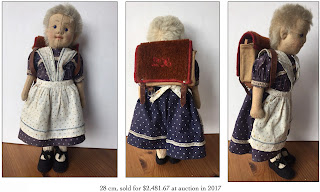First, let's get carried away and check out the detailing of this tiny treasure. The rectangular shaped backpack itself measures 8 cm x 6 cm x 2 cm overall. The front flap is made from brown mohair. The edges are trimmed in red, and it is monogrammed "DL" also in red. The rest of the case is made from brown canvas. The bottom inside is lined with a small piece of cardboard to hold the backpack's shape and angles. The backpack's straps are made from soft brown leather. They close with metal buckles and loops attached to the bottom of the backpack, and to leather straps that are attached to the front flap. The backpack itself has no specific Steiff branding to it. It does has the look, feel, and quality of the company's first quarter of the 20th century accessories - mostly seen on Steiff's military dolls in the form of soldier's kits, canteens, bread bags, etc.
But hold everything - that's not all! This little time capsule also held a delightful secret. When Steiffgal CAREFULLY opened it up, she discovered two dolly-scaled, double sided chalkboards packed perfectly within the backpack's internal storage space. These lesson boards measured 8 cm x 5 cm and were made from thick brown cardboard with a black painted center. The outer corners of each blackboard were painted silver, and each also had a little hole and a hanging string. Traces of a math lesson could be found on one of them. They also had the look, quality, and detailing of premier Steiff accessories from the first quarter of the 20th century.
So what does all this mean? This backpack was produced around 1909 or 1910 and was designed - at least in part - to go with the company's line of school children dolls. So the chalkboards make perfect sense here! Steiff designed and produced a number of classroom-style display vignettes featuring their school pupils and their perfectly to scale scholarly accessories through the early 19-teens. According to the Cieslik's Button in Ear book from 1989, "Steiff designed a few versions of this vignette, a smaller one with nine dolls as pupils and their teacher, and a larger one with 13 pupils and a teacher. All school furniture and accessories could be ordered from Steiff. In 1910 Steiff sold 45 complete school displays.” You can see a photo of one of these partial vignettes here on the left; the image is from Theriault's and they sold this set for $50,000 in 2012. Check out those backpacks and chalkboards, too!
Steiffgal hopes this discussion on this tiny, turn of last century Steiff bookbag (also pictured here on the left on a wonderful Steiff student sold on eBay a few years ago) has put you in a back-to-school sort of way.
Have a question about one of your Steiff treasures? Let's talk! Click here to learn more!

















